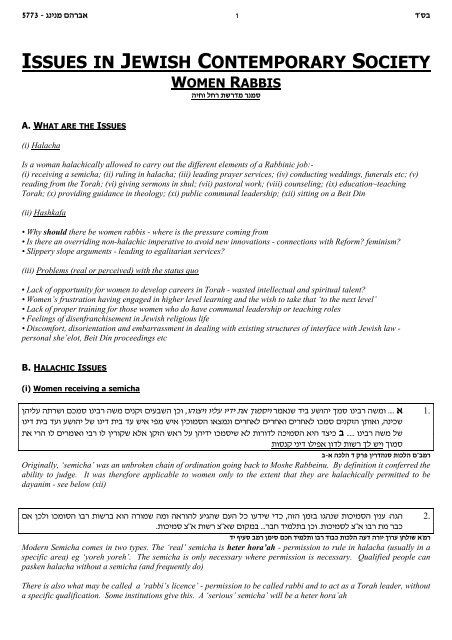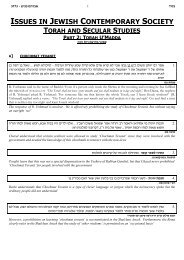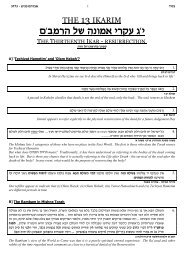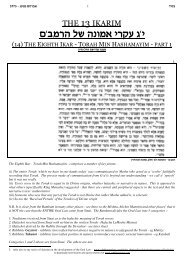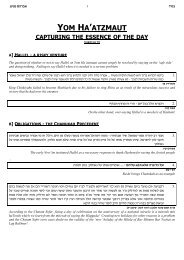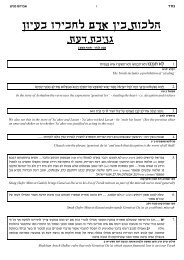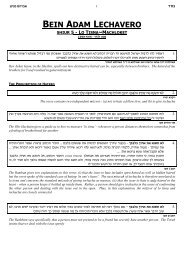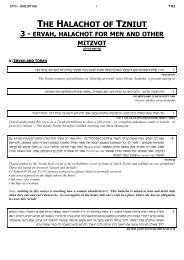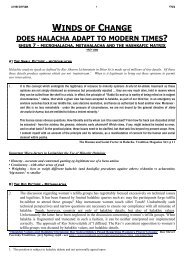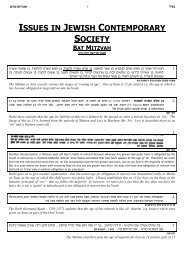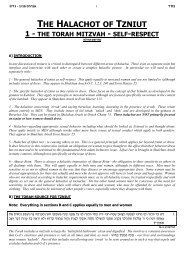Women Rabbis (Revised 5773) - Rabbi Anthony Manning
Women Rabbis (Revised 5773) - Rabbi Anthony Manning
Women Rabbis (Revised 5773) - Rabbi Anthony Manning
You also want an ePaper? Increase the reach of your titles
YUMPU automatically turns print PDFs into web optimized ePapers that Google loves.
<strong>5773</strong> - dbhbn ovrct1sxcISSUES IN JEWISH CONTEMPORARY SOCIETYWOMEN RABBISvhju kjr ,arsn rbnxA. WHAT ARE THE ISSUES(i) HalachaIs a woman halachically allowed to carry out the different elements of a <strong>Rabbi</strong>nic job:-(i) receiving a semicha; (ii) ruling in halacha; (iii) leading prayer services; (iv) conducting weddings, funerals etc; (v)reading from the Torah; (vi) giving sermons in shul; (vii) pastoral work; (viii) counseling; (ix) education~teachingTorah; (x) providing guidance in theology; (xi) public communal leadership; (xii) sitting on a Beit Din(ii) Hashkafa• Why should there be women rabbis - where is the pressure coming from• Is there an overriding non-halachic imperative to avoid new innovations - connections with Reform? feminism?• Slippery slope arguments - leading to egalitarian services?(iii) Problems (real or perceived) with the status quo• Lack of opportunity for women to develop careers in Torah - wasted intellectual and spiritual talent?• <strong>Women</strong>’s frustration having engaged in higher level learning and the wish to take that ‘to the next level’• Lack of proper training for those women who do have communal leadership or teaching roles• Feelings of disenfranchisement in Jewish religious life• Discomfort, disorientation and embarrassment in dealing with existing structures of interface with Jewish law -personal she’elot, Beit Din proceedings etcB. HALACHIC ISSUES(i) <strong>Women</strong> receiving a semichaivhkg v,rau ofnx ubhcr van ohbez ohgcav ifu 'uvumhu uhkg uhsh ,t lunxhu rntba shc gauvh lnx ubhcr vanu //// t 1.ubhs ,hc sgu gauvh ka ubhs ,hc sg aht hpn aht ihfunxv utmnbu ohrjtk ohrjtu ohrjtk ufnx ohbezv i,utu 'vbhfa,t hrv uk ohrnutu hcr uk ihruea tkt iezv atr kg ivhsh ufnxha tk ,urusk vfhnxv thv smhf c ///// ubhcr van ka,uxbe hbhs ukhpt iusk ,uar lk ahu lunxc-t vfkv s erp ihrsvbx ,ufkv o"cnrOriginally, ‘semicha’ was an unbroken chain of ordination going back to Moshe Rabbeinu. By definition it conferred theability to judge. It was therefore applicable to women only to the extent that they are halachically permitted to bedayanim - see below (xii)ot ifku ufnuxv ucr ,uarc tuv vruna vnu vtruvk ghdva ogv kf ugsha hsf 'vzv inzc udvba ,ufhnxv ihbg :vdv 2./,ufhnx m"t ,uar m"ta ouenc ///rcj shnk,c ifu /,ufhnxk m"t ucr ,n rcfsh ;hgx cnr inhx ofj shnk,u ucr sucf ,ufkv vgs vruh lurg ijkua tnrModern Semicha comes in two types. The ‘real’ semicha is heter hora’ah - permission to rule in halacha (usually in aspecific area) eg ‘yoreh yoreh’. The semicha is only necessary where permission is necessary. Qualified people canpasken halacha without a semicha (and frequently do)There is also what may be called a ‘rabbi’s licence’ - permission to be called rabbi and to act as a Torah leader, withouta specific qualification. Some institutions give this. A ‘serious’ semicha’ will be a heter hora’ah
<strong>5773</strong> - dbhbn ovrct2sxc(ii) <strong>Women</strong> ruling in halachavatc ifu 'ohrfzc inz kfcu ouen kfc vtruvv ,ghbnu ',ucebu ohrfzc ,hcv inzc ,urfac asen ,thc ruxht dvubu 3.,uruvk vhutrv vnfjcbe vumn lubhjv rpxIn dealing with the issur of ruling in halacha when intoxicated, the Sefer Hachinuch (Spain 13C) adds that thisprohibition also relates to a woman who is trained in ruling in halacha. He takes for granted that there is no halachicproblem with a women doing sovtruv ,uruvk vkufh vnfj vat n"n iusk vkuxp vats ;t 'c"h ,ut ;xuh hfrc rpxc c,fu 4.v e"x z inhx ypan iauj vcua, hj,pThe Pitchei Teshuva on Shulchan Aruch paskens that a woman may pasken halacha if she is qualified. Rav Ovadia Yosefrules that a person must stand up for a woman who is a talmidat chacham5.j:jf ltcrghut sus cr - v,hc ,ufhkv rpxThis is also the psak of Rav David Auerbach in his sefer on women’s halacha(iii) <strong>Women</strong> leading prayer servicesLeading prayer services in synagogue is not in principle a rabbinic role, but has de facto become such in manycommunities.For various halachic reasons, it would not be possible for women to do this, at least not fully. Factors includes:-• the different obligations of men and women and inability to be ‘motzi’ - eg chazarat hashatz• kol isha(iv) <strong>Women</strong> officiating at weddingsorudu vurgv ,t rh,hu ,ugyk kufh keca 'ovc ,uruvk ovng exg uk tvh tk ihauseu ihyhd chyc hec ubhta hn kf 6.ktrahc ohrznn ,ucrvkd ;hgx yn inhx ihaushe ,ufkv rzgv ict lurg ijkuaThe Shulchan Aruch warns against anyone officiating at a divorce or wedding who is not properly qualified. This has nodirect bearing on gender unless there is an element of dayanut involved (as in gittin)In terms of the halachot of kiddushin taken in a vacuum there is no obvious prohibition to greater involvement by womenin the wedding ceremony, including• Reading the ketuba - which has no halachic significance other than to create a delay between the kiddushin and thenisuin and so could be read by anyone. (You could have a live video link of someone across the world reading theketuba!)• Bircat Erusin and Bircat Nisuin (sheva berachot) - although many sefarim bring that a woman may NOT recite theseberachot, the halachic origins of this seem to be based in other halachic areas - eg hilchot tzniutBUT there may be significant meta-halachic or hashkafic problems - see belowWhv«kto g ,fk gb m v u s x j , cvt u yP J n ,IGgo t h F W N n JrIS «vv nU cIYv n o s t Wk shDv 7.j:u vfhnThe Navi Micha reduced the key elements of a Torah life to 3 main ideas, one of which is tzniut
<strong>5773</strong> - dbhbn ovrct3sxcvpujk vkf ,xbfvu ,nv ,tmuv uz - lhvkt og ,fk gbmvu 8.:yn vfuxChazal identified tzniut specifically with the public occasions of weddings and funerals. Even on such occasions, whichdemand a public interface, a persons should be focused on the need to remain tzanua (see xiii below)(v) <strong>Women</strong> reading from the TorahAgain, this has become a practical rabbinic role in many communities where there is no one else. The halachic issues asmore complex than in (iii). They include:-• <strong>Women</strong>’s aliyot and the concept of kavod hatzibur• (Possibly) kol isharucm sucf hbpn 'vru,c tre, tk vat :ohnfj urnt kct /vat ukhptu /// 'vgca ihbnk ihkug kfv :ibcr ub, 9/df vkhdnThe Gemara write that women MAY in principle be called up to read from the Torah but, in practice, we do not do thisdue to ‘kavod hatzibur’. What exactly this is, whether it is absolute or can be set aside in some circumstances andwhether we define it objectively or subjectively, is a topic for another class. However, it will also have ramifications forthe debate on women <strong><strong>Rabbi</strong>s</strong>(vi) <strong>Women</strong> giving sermons in shulThe halachic issue here is tzniut - see below(vii) <strong>Women</strong> performing pastoral work; (viii) counseling; (ix) education~teaching Torah; (x) providingguidance in theologyThere are obviously no halachic impediments to women being involved in these activities, subject to the laws of tzniut(xi) <strong>Women</strong> in communal leadership positions///// Wh j t crE n IC Wh v«kt v r j ch r Jt Qk n Whkg oh G T oIG 10.uy:zh ohrcsThe Torah includes a mitzva to appoint a king over the Jewish peoplevfkn tku 'lkn 11.zbe texhp ohypua ,arp ohrcs hrpxChazal in the Sifrei (Israel 3C) understand that the reference to a ‘melech~king’ excludes the possibility of a queenlhjt cren tkt vhvh tk ohan v,ta ,unhan kf - lhjt cren ///lkn lhkg oha, oua (zh ohrcs) /tbhb, 12.:ug ihausheChazal see this mitzva to appoint a king as a prototype for all communal public appointmentstkt ivc ihbnn iht ktrahca ,unhan kf ifu ,ufknc vat ihshngn ihta snkn /vfkn tku -lkn lhkg oha, oua t"s 13.:ahtzh erp ohrcsk ohtb, arsnChazal in the Medrash Tanaim (a lesser known halachic medrash on the book of Devarim) apply the prohibition toappointing women to all positions of communal authority
<strong>5773</strong> - dbhbn ovrct4sxcaht tkt ovc ohbnn iht ktrahca ,unhan kf ifu 'vfkn tku lkn lhkg rntba ,ufknc vat ihshngn iht14.v vfkv t erp ohfkn ,ufkv o"cnrAs such, when the Rambam paskens this halacha in the Yad Chazaka (Egypt 12C) he extends the issur to appointing anywomen to ‘mesima shebeyisrael’ - Jewish public office. In the context of this prohibition, this could be an issur TorahIt should be noted that he ALSO extends the prohibitions of public appointments to other groups disqualified fromkingship eg converts. So it is not necessarily to do with ‘women’ per se. He understands, like the gemara in Kiddushin,that the mitzva to appoint a melech is dealing with all public appointments and the same qualifications anddisqualifications will apply across the boardvhv rucsv p"g b"t ohypanv ovk ,snkn v,hva thae tk 'ktrah ,t vypua thv vthcb vat vrucsu ch,f tv ,"tu 15.v vfkv t erp ohfkn ,ufkv z"csrThe Radvaz (Egypt 16C) ask on this Rambam from the example of Devora, who judged Israel at the time of the Shoftim.he gives two answers; (i) Devora was a teacher of halacha and Torah not a leader (another proof for the discussionabove) and (ii) Devorah was a leader but was exceptionally sanctioned by Hashem through Nevuah (these answers arealready found in Tosafot on Niddah 50a)uhva vz 'ypank ktrah hbc vhkt ukghu hnb ch,fu 'ktrah ,t vypa thvu (s ohypua) vrucs kg cu,fv rnta vnu 16.tkt ',unhan rtak ihsv tuvu vfkn tku lkn lhkg oha, oua hrpxc ibhrnt tvs 'hubhn ,ru,c tk vhp kg ohdvb,n,usg u,usgu ihs ubhs kuxp ut cure ,usgku ihsk uhkg kcenva ihsk ovhkg vukcea ut 'v,mg hp kg ohdvb,nat sung k ;s ,uguca ,fxn t"cyhrv haushjThe Ritva (Spain 14C) agrees with the Rambam’s position on the prohibition of appointing women to positions ofauthority. He also raises the question of Devorah but gives two different answers (i) Devorah was not formallyappointed but the people went to her for advice; (ii) Devorah was not really halachically acceptable for the role sheperformed but the people accepted her as a judge in spite of that. In a case where a person accepts an otherwise invalidwitness or judge (eg a relative) the appointment and judgement are valid. It is interesting to consider what effect thislatter rationale would have on a modern community’s decision to accept a female leaderod rcux ifa rc,xnu hdhkp i"cnru i"rvu a"trvu wxu,u h"ar kct o"cnrvf ohrcuxv ohbuatr vcrv aha ;t rcs ;ux 17.tfhka iputc er tuv htsucu /tuv t,uucrs t,dukps iuhf vhnhgsu o"cnrv ,yhaf rhnjvk ah vagnk htsucu t"carvkusd lrumk ifku /sujh ihbg iushb kkf lhha tku ohab og tuv exgv rehg hrv h,ktaba vjdavu vnusfu sujh ruxhtod ohhek vmg h,tmn kct t,uucrs t,dukp kfcf o"cnrv kg ohekujv kg lunxk lhha vhv vhbcu vbnktv ,uhj khcac/ohekujv kg lunxk lrum tfhk tkhnn hrva vmgvf ,uagk ihjrfun tkhnnu o"cnrv ,yhavn inhx c ekj vgs vruh van ,urdt ,"uaRav Moshe Feinstein has two teshuva concerning appointing a woman as a kashrut mashgiach. In the course of thoseteshuvot, he deals in details with the issue of appointing a woman to leadership roles. He finds that, although manyRishonim do agree with the Rambam that it is prohibited, many others do NOT agree. Rav Moshe rules that we shouldnormally rule in such cases like the Rambam but in special circumstances (like the ones in this teshuva) he is prepared tobe lenient and rule against the RambamThis of course does not in any sense imply that Rav Moshe would be lenient in debate on women rabbis. It does howevershow that the halachic position is subject to dispute.In October 1931, <strong>Rabbi</strong> Yehiel Ya’akov Weinberg, one of the great rabbinic authorities of the 20th century, agreed thatthere was no halachic bar to women being elected to the heads of communities, but since there was a consensus that itwas not modest or appropriate, he felt that there should be no change in public policy. In a later response of 1960, hesuggested that the matter must be left to work itself out. His response followed a private letter in which he pointed outthat while the scholars of the ultra-Orthodox world opposed women’s suffrage, in Israeli elections even ultra-Orthodoxwomen vote.Note that the United Synagogue - one of the main Orthodox synagogue bodies in London have just elected their firstwoman chairman of a shul, following a ruling of the London Beit Din last December that this was not in breach ofhalacha
<strong>5773</strong> - dbhbn ovrct5sxc(xii) <strong>Women</strong> as judgesohabtv hba usngu (y"h ohrcs):r",s ?hkhn hbvbn /wnd //// ohabc tku ohabtc ,dvub ,usgv ,guca /whb,n 18./k ,uguca<strong>Women</strong> are invalid as witnesses in court proceedings, as learnt from a passukiusk vkuxp vat 19.s ;hgx z inhx ohbhhs ,ufkv ypan iauj lurg ijkuaThe Shulchan Aruch rules that women are invalid as judges,usgn vk ibhpkh /iusk vkuxp vat 20.h e"x z inhx g"nxThis is learnt by some authorities as an extension of the invalidation as witnesses. Others learn it from ‘melech velomalka’ - see aboveihsv vhv tka .r,k ubk rapta 'ktrah ,t vypua thv (s:s ohypua) vthcbv vrucsc cu,fa vn lhbhgc vaeh tku ///// 21.ifku 'if od ihbhsu r,hvu ruxht ka ohrcsc ukhpt vng ohb,ubu ohtaub uhvu vthcbu vnfj vat v,hv kct vhp kg l,jbvkcecs 'vhp kg iush ost kf ivhrjtu ktrah hatr ovhkg iusk vukcea rntb ut /ktrah ,t vypua thv vhkg cu,f,gsfu oharpnv ,me ,gsf tuv ,ubs ibhta ubrnta vz kf ouen kfnu /ohhe iunnca htb, kfs 'ohraf kfv htsuthv rntba tuv tkn tren hf urntu 'iusk iv ,uraf oharpnv in ,me ,gsk kct /arupn oa tmnb ifa 'hnkaurhve"c) oa jfunsf shgvk ,uraf ibht htsu ohabu 'iusk raf ubht shgvk raf ubhta kfs (:sk) ihrsvbxc urnta vnu 'vypuaibhta trcxv inu ohrcsv in vtrbvu /(/zf ihcurhg) ,ukkfv in ihsnk ihta hpk vz o,gs hpk urntha rapt '(/k ,uguca '/jp,uyhap lrs ihrnd hpk gnansfu hnkaurhc t,htsf 'ihs ,ru,czg vumn lubhjv rpxThere is another position, brought here in Sefer Hachinuch, which holds that women CAN be judges and that Devorahwas a judge. This opinion was not followed in halacha by the Shulchan Aruch(xiii) Tzniutgh JIn k t rGh h v«kt r T T x n k t v T t if t 22.uy:vn uvhgahOne of the middot of Hashem is to remain hidden. Since we have a mitzva of ‘vehalachta bedrachav’ - to copy the Divinemiddot, this makes ‘histatrut’ - remaining private an overriding midda within Judaism(vhkgc ,t ,rcen ,ubcrva 'rucm kg vrra duvbkn ejr,v :trubyrcn gr) ,ubcrv ,t tbau vftknv ,t cuvt rnut vhgna /// 23.h:t erp ,uct ,fxn vbanAs such, we are encouraged to avoid leadership positions (Yosef’s early death is seen by Chazal as a result of hisleadership):V JUck c vz ,Im C J N n v nhb P Qk n , c v SUc F kF 24.sh euxp vn erp ohkv,This is especially true of women who are doubly encouraged to maintain a more private roletch,f tks d"gtu ktrah ,ubc udvba - ,hsuvh ,s 25.t sung cg ;s ,ucu,f ,fxn h"arThe halachic parameters of hilchot tzniut are defined by ‘dat yehudit’ - the religious practices of the Jewish people. In thecontext of women’s practice of tzniut, Rashi defines ‘dat yehudit’ as ‘the minhag of Jewish women in areas that have nowritten source’. Thus, many aspects of dat yehudit are based in hilchot minhag and will by definition be subjective
<strong>5773</strong> - dbhbn ovrct6sxc/h"b kgppt h"rvn wufu v"gux c"uj wdv crv rehv hshsh////// vrybun t"ha, vfubjs wd v"c :rjchvku rujck ,ukufh ohab ot 26.hbcr okut /,hchxtpv vrhjcv ,t rxtu ,hchyetv vrhjc ,t rh,v k"z inpuv m"s r"dv /ohab ,rhjcc u,kta s"g ////,t rh,n kthzug hypan urpxc kthzug hatrv crvu ',hchyetv vrhjcv od urxt 'sugu k"z g"jrdvu k"z j"j kgc ifu h"tod 'kveu ruchm hbhhbgc euxg, vata ,ughbmv sdb uvza 'hrxun ogy ah ohrxutvk //// sjh od rjcvku rujck vrhjcvihta 'ovhkg ihbnzn iht ohbyeu ohscgu ohab 'v"n ,ufrcn ifu '"vfkn tku 'lkn" :z"be 'ohypua hrpxn whtr ohthcnkupkpc ,kgu, iht kct 'kpkpku ,ujsk ahu /a"hg 'rucm sucf hbpn vru,c tre, tk vat 'd"f vkhdnc ifu /vtb o,rcjoheung r,uh ohngy vzc ah hfyn, sung jke inhx t ekj at hshra ,"uaThis teshuva of the Seridei Eish (written 1951) deals with the issue of women’s right to vote and records the opinion ofmany early 20C opinions that it was totally assur. These opinions include the Chafetz Chaim, R. Chaim Ozer Grodzinskyand other authorities (R. Yehoshua Leib Diskin, R. Yosef Chaim Sonnenfeld, R. Yechiel Michel Tukachinski)27.(1919) pr, hra, eue ht r - ohab ,rhjc kg c,fnRav Kook was also totally against women voting on various grounds, including tzniutFollowing the radical shift in the structure of society over the last 90 years since WWI, orthodox women now vote withoutany hesitation and with full <strong>Rabbi</strong>nic approval. What changed? Evidently, women voting IS now tzanuah. Thus any issurbased on hilchot tzenuit is always a potentially moving target.B. META-HALACHIC~HASHKAFA ISSUES• <strong>Women</strong> rabbis would never be able to fill all the roles of communal rabbi (see above). Would their ordination thereforelead to a frustration amongst women rabbis which, itself, would impose pressure to pursue entirely non-halachicchoices?• <strong>Women</strong> <strong><strong>Rabbi</strong>s</strong> would be entirely rejected by a large proportion of the Orthodox world. Would this not thereforeintroduce a new element of friction and machloket into the community• Are there other fulfilling roles that women can be encouraged to pursue in Jewish learning and teaching? What abouteducation? toenot Beit Din? Yoetzot? Should these be encouraged or discouraged? Should there be a title of poseket oris this just as problematic as a woman <strong>Rabbi</strong>?• There is an issur to innovate in a way which would strengthen the position of sectarian Jewish groups,t vejh tka 'if vagh tk euacu `vfu,k osv xbfha khcac u,hc lu,c tnud vaug kct 'rehg kf tnudk ihyjua iht 28.(euj iuak vejh 'ovh,ueujc ovhsh ehzjh - h"ar) :[ohbhnv] oheusmv/tn ihkujThe Mishna prohibits shechita in a way which would give support to sectarian practices of ‘non-orthodox’ groups, eventhough the innovation is itself halachically permissible. There have always been such group - Samaritans, Sadduces,Early Christians. Today, this would apply to adopting practices which would strengthen the position of non-orthodoxgroups - Conservative, ReformThis has been applied over the last 200 years in various questions:-- prohibiting organs in synagogues- prohibiting flowers at funerals- prohibiting changes to synagogue design
<strong>5773</strong> - dbhbn ovrct7sxcBut note that some innovations have been gradually accepted in many quarters:-- Bat Mitzva- giving derashot in the venacular• Is the pressure for women <strong><strong>Rabbi</strong>s</strong> coming from a secular feminist egalitarian agenda? To what extent are desires forinnovation leshem shamayim?


